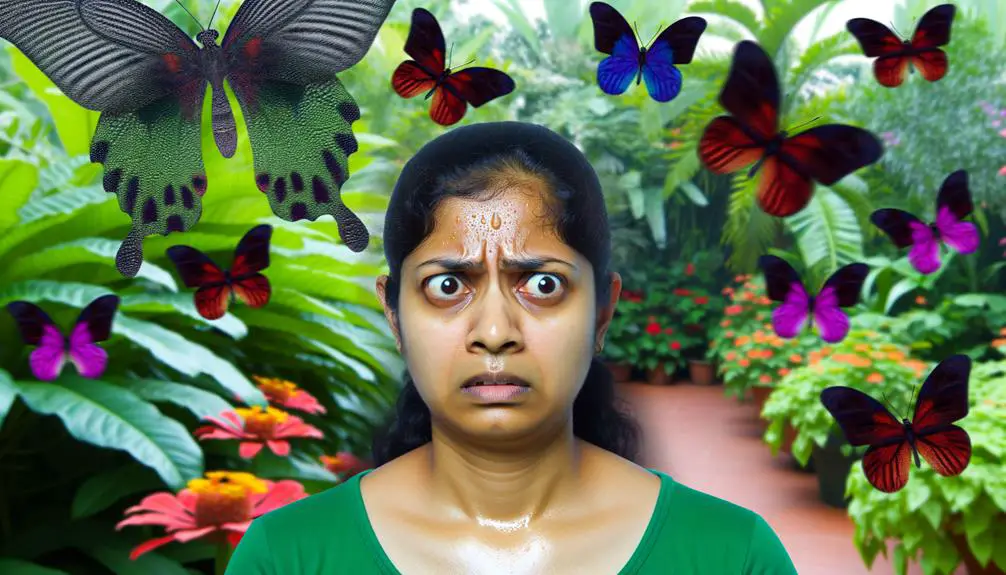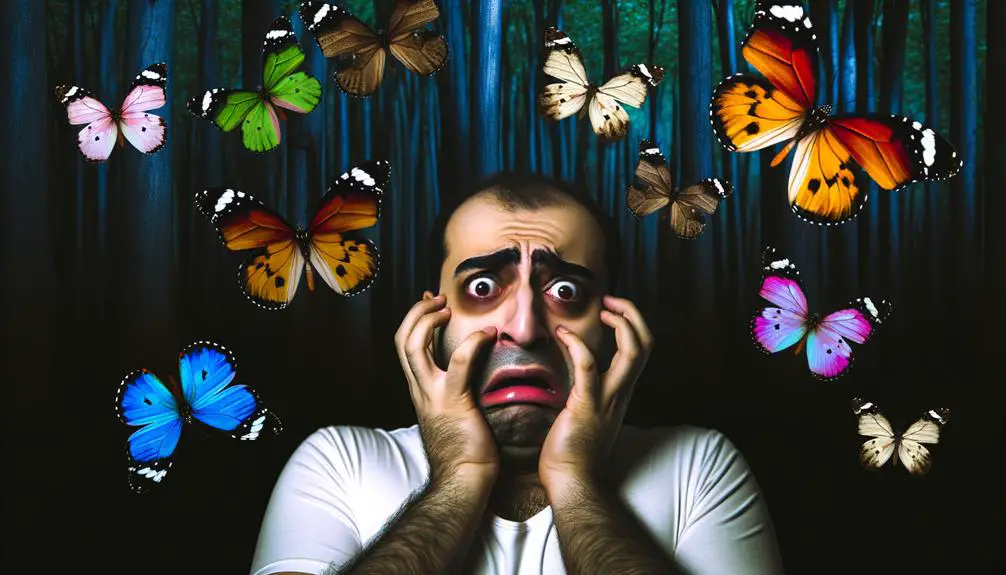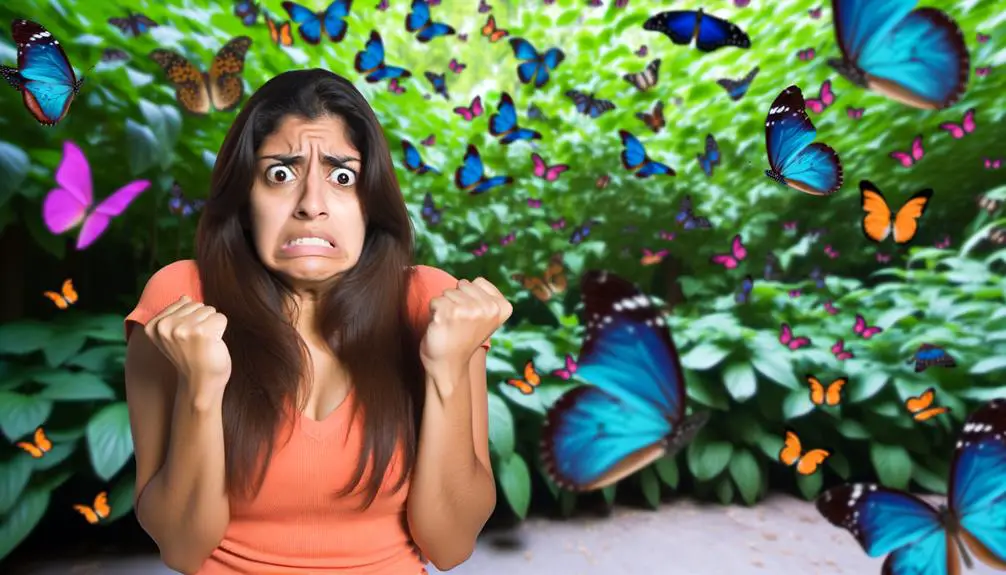What Is the Fear of Butterflies Called?
Lepidopterophobia is a specific phobia characterized by an intense and irrational fear of butterflies and moths. This anxiety disorder can greatly impair one's daily life, with symptoms including elevated heart rates, sweating, intense fear, and avoidance behaviors.
Psychological origins may involve conditioned responses from negative childhood experiences, cognitive biases, and possible genetic predispositions. Treatments such as Cognitive Behavioral Therapy (CBT) and exposure therapy have proven effective in managing this phobia.
A deeper understanding of the historical, cultural, and psychological contexts provides insight into this condition's complexity and possible approaches to treatment.

Key Takeaways
- Lepidopterophobia is the intense and irrational fear of butterflies and moths.
- It is classified as a specific phobia within anxiety disorders.
- Symptoms include elevated heart rate, sweating, and panic attacks.
- Treatment options include Cognitive Behavioral Therapy and exposure therapy.
Definition of Lepidopterophobia

Lepidopterophobia, clinically recognized as an intense and irrational fear of butterflies and moths, is a specific type of phobia categorized under anxiety disorders. This condition manifests through disproportionate fear responses when encountering butterflies or moths, often leading to avoidance behaviors that can disrupt daily activities. Symptoms may include elevated heart rate, sweating, and severe anxiety.
Research indicates that such phobias can originate from traumatic experiences, genetic predispositions, or observational learning. Diagnosis typically involves a thorough psychological assessment to rule out other anxiety-related conditions.
Cognitive-behavioral therapy (CBT) is often recommended as an effective treatment, focusing on exposure and desensitization techniques to alleviate phobic responses. Understanding the underlying causes is essential for effective intervention and management.
Historical Background
Tracing the historical background of lepidopterophobia reveals that the fear of butterflies and moths has been documented across various cultures and epochs, often linked to symbolic interpretations and mythological associations.
Notable historical references include:
- Ancient Greece: Butterflies were associated with the soul, and their presence was sometimes seen as an omen.
- Medieval Europe: Moths, particularly, were often viewed as harbingers of death or bad luck.
- Japanese Folklore: Butterflies were seen as the souls of the living or the dead, creating a dual sense of beauty and fear.
- Indigenous Cultures: Some Native American tribes viewed moths as symbols of transformation but also as messengers of misfortune.
These historical connections provide context for understanding contemporary manifestations of lepidopterophobia.
Psychological Origins

Understanding the psychological origins of lepidopterophobia involves examining the cognitive and emotional mechanisms that contribute to the development of this specific fear.
Cognitive-behavioral theories suggest that irrational fears, including lepidopterophobia, may be learned through direct negative experiences or observational learning. Emotional responses such as anxiety may become conditioned to the presence of butterflies, reinforcing avoidance behavior.
Additionally, evolutionary psychology posits that fear responses may be hardwired to avoid potential threats, even if irrationally perceived. Neurobiological factors, such as amygdala hyperactivity, could further exacerbate these fear responses.
Evidence indicates that genetic predispositions, combined with environmental triggers, contribute to the manifestation of lepidopterophobia.
Understanding these multifaceted origins is essential for developing effective therapeutic interventions.
Common Symptoms
Individuals experiencing fear of butterflies, or lepidopterophobia, commonly exhibit both physical and emotional symptoms.
Physical reaction signs may include increased heart rate, sweating, and gastrointestinal distress.
Emotional distress indicators often encompass intense feelings of anxiety, panic, and an overwhelming need to avoid the perceived threat.
Understanding these symptoms is essential for diagnosing and managing this specific phobia effectively.
Physical Reaction Signs
Many individuals with a fear of butterflies exhibit physical reaction signs such as increased heart rate, sweating, and shortness of breath. These symptoms are consistent with a physiological response to anxiety and can be distressing.
Clinically, the following are common physical reactions observed in individuals with this specific phobia:
- Increased Heart Rate: The body's fight-or-flight response triggers a rapid heartbeat.
- Sweating: Excessive perspiration, particularly on the palms and forehead, is a typical reaction.
- Shortness of Breath: Difficulty breathing or a sensation of choking may occur.
- Trembling or Shaking: Muscle tension and shivering can be evident, especially in the presence of butterflies.
Understanding these symptoms is essential for diagnosing and managing this phobia effectively.
Emotional Distress Indicators
In addition to physical reactions, individuals with a fear of butterflies often experience considerable emotional distress, characterized by heightened anxiety, feelings of dread, and pervasive unease. This distress can lead to avoidance behaviors, where individuals go out of their way to steer clear of places where butterflies might be present. The fear may also extend to images or even conversations about butterflies, triggering discomfort. In some cases, simply hearing someone ask how to say butterfly in Italian could evoke anxiety, as it brings the unsettling subject to mind.
This psychological discomfort can manifest as anticipatory anxiety, where the individual becomes anxious at the mere thought of encountering a butterfly. Emotional responses may include panic attacks, characterized by rapid heart rate, sweating, and difficulty breathing.
Additionally, sufferers may exhibit avoidance behaviors, such as steering clear of outdoor areas where butterflies are commonly found. This avoidance can considerably impact daily functioning and quality of life.
Cognitive symptoms often include intrusive thoughts and irrational fears, which can exacerbate the emotional turmoil, creating a cyclical pattern of distress difficult to break without intervention.
Case Studies

A thorough examination of documented case studies reveals critical insights into the manifestation and treatment of lepidopterophobia. The following cases highlight diverse presentations and therapeutic approaches:
Case Study 1: A 34-year-old female experiencing severe anxiety and avoidance behaviors when encountering butterflies. Cognitive-behavioral therapy (CBT) considerably reduced symptoms over a 12-week period.
Case Study 2: A 22-year-old male with a history of traumatic childhood experiences involving insects, including butterflies. Psychodynamic therapy was effective in uncovering and addressing underlying trauma.
Case Study 3: An 8-year-old child displaying intense fear and panic at the sight of butterflies. Gradual exposure therapy in a controlled environment proved successful.
Case Study 4: A 45-year-old male with generalized anxiety disorder and specific phobia of butterflies. A combination of medication and CBT yielded positive outcomes.
These cases underscore the importance of tailored therapeutic strategies.
Coping Mechanisms
Effective coping mechanisms for lepidopterophobia often involve a combination of psychological strategies and therapeutic interventions tailored to the individual's specific needs.
Cognitive-behavioral techniques, such as cognitive restructuring and exposure therapy, are frequently employed to help individuals reframe irrational thoughts and gradually desensitize to butterflies.
Mindfulness practices, including meditation and deep-breathing exercises, can assist in managing acute anxiety symptoms.
Psychoeducation provides the individual with a better understanding of their phobia, fostering a sense of control.
Additionally, support groups offer a communal environment for sharing experiences and strategies.
Self-help resources, such as guided imagery and relaxation techniques, further empower individuals to manage their fear outside a clinical setting.
Treatment Options

Several evidence-based treatment options are available for individuals suffering from lepidopterophobia. These methods are designed to reduce symptoms and improve overall quality of life through structured, clinically validated approaches:
- Cognitive Behavioral Therapy (CBT): CBT helps patients identify and challenge irrational fears and beliefs about butterflies, promoting healthier thought patterns.
- Exposure Therapy: Gradual and controlled exposure to butterflies can help desensitize individuals to their fear, reducing anxiety over time.
- Medication: Antidepressants or anti-anxiety medications may be prescribed to manage severe symptoms, though they are typically used in conjunction with other therapies.
- Mindfulness and Relaxation Techniques: Practices such as deep breathing and meditation can help manage the physiological responses associated with lepidopterophobia.
These strategies are tailored to individual needs for ideal outcomes.
Expert Opinions
Leading psychologists emphasize the role of cognitive-behavioral therapy (CBT) in addressing the underlying cognitive distortions associated with lepidopterophobia.
Additionally, experts advocate for exposure therapy as a highly effective treatment approach, gradually desensitizing patients to butterflies.
Current evidence supports these methods as the most efficacious interventions for mitigating fear responses in affected individuals.
Psychological Perspective
A multitude of psychological experts have explored the origins and mechanisms of lepidopterophobia, presenting evidence-based theories that examine its cognitive and behavioral dimensions.
Research has identified several contributory factors:
- Conditioned Responses: Negative experiences with butterflies during childhood can lead to conditioned fear responses.
- Evolutionary Factors: Some theories suggest that fear of insects, including butterflies, may be an inherited survival mechanism.
- Cognitive Biases: Individuals with lepidopterophobia often exhibit cognitive distortions, such as overestimating the threat posed by butterflies.
- Social Learning: Observing fearful reactions in others, including family members, can facilitate the development of similar phobias.
These dimensions collectively provide a thorough understanding of the psychological underpinnings of lepidopterophobia.
Treatment Options
In the domain of therapeutic interventions, experts emphasize the efficacy of evidence-based treatments such as cognitive-behavioral therapy (CBT) for managing lepidopterophobia. CBT enables patients to identify and challenge irrational fears associated with butterflies, fostering desensitization through gradual exposure. Additionally, medications like selective serotonin reuptake inhibitors (SSRIs) may be prescribed to alleviate severe anxiety symptoms. Another promising approach is mindfulness-based stress reduction (MBSR), which helps patients remain grounded during exposure exercises. The combination of these treatments may vary based on individual needs, but the overarching goal remains the same: to reduce fear and improve quality of life.
| Treatment Type | Description | Efficacy %
| ————————- | —————————————————– | ———– |
|---|---|---|
| Cognitive-Behavioral Therapy (CBT) | Identifies and challenges irrational fears | High |
| Selective Serotonin Reuptake Inhibitors (SSRIs) | Medications to reduce anxiety | Moderate |
| Mindfulness-Based Stress Reduction (MBSR) | Techniques to stay grounded during exposure | Moderate |
| Combination Therapy | Use of multiple treatments tailored to the patient | Variable |
Conclusion
The labyrinthine nature of lepidopterophobia, encompassing historical, psychological, and symptomatic dimensions, underscores its complexity.
Case studies illustrate its varied manifestations, while coping mechanisms and treatment options provide avenues for relief.
Expert opinions further validate the efficacy of evidence-based interventions.
Like a tapestry woven with intricate threads, understanding lepidopterophobia requires a multidisciplinary approach, integrating clinical insights and empirical research to mitigate its impact on individuals' lives.
Extensive analysis reveals the potential for effective management and improved quality of life.






